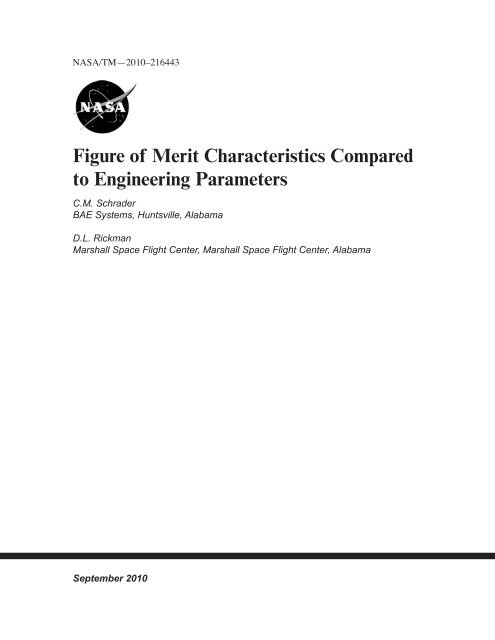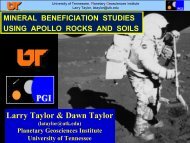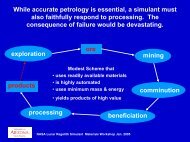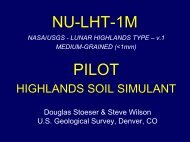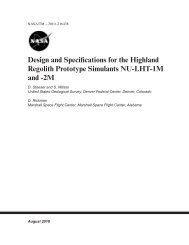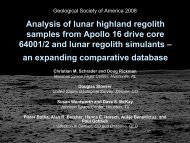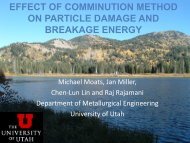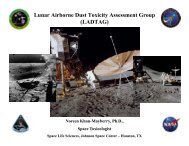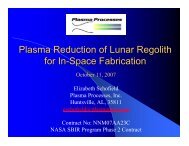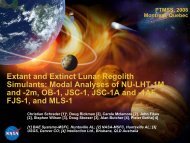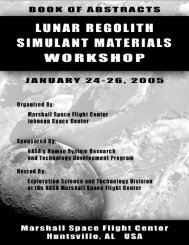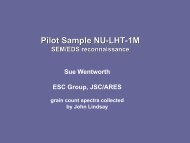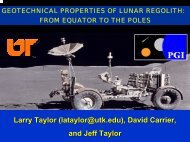Figure of Merit Characteristics Compared to Engineering Parameters
Figure of Merit Characteristics Compared to Engineering Parameters
Figure of Merit Characteristics Compared to Engineering Parameters
You also want an ePaper? Increase the reach of your titles
YUMPU automatically turns print PDFs into web optimized ePapers that Google loves.
NASA/TM—2010–216443<strong>Figure</strong> <strong>of</strong> <strong>Merit</strong> <strong>Characteristics</strong> <strong>Compared</strong><strong>to</strong> <strong>Engineering</strong> <strong>Parameters</strong>C.M. SchraderBAE Systems, Huntsville, AlabamaD.L. RickmanMarshall Space Flight Center, Marshall Space Flight Center, AlabamaSeptember 2010
The NASA STI Program…in Pr<strong>of</strong>ileSince its founding, NASA has been dedicated <strong>to</strong> theadvancement <strong>of</strong> aeronautics and space science. TheNASA Scientific and Technical Information (STI)Program Office plays a key part in helping NASAmaintain this important role.The NASA STI Program Office is operated byLangley Research Center, the lead center forNASA’s scientific and technical information. TheNASA STI Program Office provides access <strong>to</strong>the NASA STI Database, the largest collection <strong>of</strong>aeronautical and space science STI in the world.The Program Office is also NASA’s institutionalmechanism for disseminating the results <strong>of</strong> itsresearch and development activities. These resultsare published by NASA in the NASA STI ReportSeries, which includes the following report types:• TECHNICAL PUBLICATION. Reports <strong>of</strong>completed research or a major significantphase <strong>of</strong> research that present the results <strong>of</strong>NASA programs and include extensive dataor theoretical analysis. Includes compilations<strong>of</strong> significant scientific and technical dataand information deemed <strong>to</strong> be <strong>of</strong> continuingreference value. NASA’s counterpart <strong>of</strong> peerreviewedformal pr<strong>of</strong>essional papers but has lessstringent limitations on manuscript length andextent <strong>of</strong> graphic presentations.• TECHNICAL MEMORANDUM. Scientificand technical findings that are preliminary or <strong>of</strong>specialized interest, e.g., quick release reports,working papers, and bibliographies that containminimal annotation. Does not contain extensiveanalysis.• CONTRACTOR REPORT. Scientific andtechnical findings by NASA-sponsoredcontrac<strong>to</strong>rs and grantees.• CONFERENCE PUBLICATION. Collectedpapers from scientific and technical conferences,symposia, seminars, or other meetings sponsoredor cosponsored by NASA.• SPECIAL PUBLICATION. Scientific, technical,or his<strong>to</strong>rical information from NASA programs,projects, and mission, <strong>of</strong>ten concerned withsubjects having substantial public interest.• TECHNICAL TRANSLATION.English-language translations <strong>of</strong> foreignscientific and technical material pertinent <strong>to</strong>NASA’s mission.Specialized services that complement the STIProgram Office’s diverse <strong>of</strong>ferings include creatingcus<strong>to</strong>m thesauri, building cus<strong>to</strong>mized databases,organizing and publishing research results…evenproviding videos.For more information about the NASA STI ProgramOffice, see the following:• Access the NASA STI program home page at• E-mail your question via the Internet <strong>to</strong>• Fax your question <strong>to</strong> the NASA STI Help Deskat 443 –757–5803• Phone the NASA STI Help Desk at443 –757–5802• Write <strong>to</strong>:NASA STI Help DeskNASA Center for AeroSpace Information7115 Standard DriveHanover, MD 21076–1320
NASA/TM—2010–216443<strong>Figure</strong> <strong>of</strong> <strong>Merit</strong> <strong>Characteristics</strong> <strong>Compared</strong><strong>to</strong> <strong>Engineering</strong> <strong>Parameters</strong>C.M. SchraderBAE Systems, Huntsville, AlabamaD.L. RickmanMarshall Space Flight Center, Marshall Space Flight Center, AlabamaNational Aeronautics andSpace AdministrationMarshall Space Flight Center • MSFC, Alabama 35812September 2010i
Available from:NASA Center for AeroSpace Information7115 Standard DriveHanover, MD 21076 –1320443 –757– 5802This report is also available in electronic form atii
LIST OF TABLES1. Properties from the 2005 Lunar Simulant Workshop, from table 2 in Sibille et al. ........ 52. Properties from 2005 workshop correlated <strong>to</strong> FoM properties by which theyare directly addressed or from which they are derived .................................................. 6v
LIST OF ACRONYMSBrClCO 2FFe 0FoMH 2 OIISRUMSFCnFe 0OHPTMbrominechlorinecarbon dioxidefluorineiron metalfigure <strong>of</strong> meritwateriodinein situ resource utilizationMarshall Space Flight Centernanophase iron metalhydroxylphosphorousTechnical Memorandumvii
viii
TECHNICAL MEMORANDUMFIGURE OF MERIT CHARACTERISTICS COMPAREDTO ENGINEERING PARAMETERS1. INTRODUCTIONCurrent NASA lunar architecture calls for permanent human habitation <strong>of</strong> the Moon bythe year 2020. Due <strong>to</strong> the expense <strong>of</strong> delivering materials in<strong>to</strong> orbit, technologies are being developed<strong>to</strong> use lunar regolith for building and as a material resource for fabrication, oxygen production,and other needs. Additionally, constant exposure <strong>to</strong> the finest size fraction <strong>of</strong> lunar regolithmay present hazards <strong>to</strong> human health. Towards developing these technologies and mitigatinghazards, lunar regolith simulants are becoming an increasingly important part <strong>of</strong> the developmentparadigm.1.1 2005 Regolith Simulant WorkshopIn January 2005, Marshall Space Flight Center (MSFC) hosted a workshop in Huntsville,AL, <strong>to</strong> discuss the future development <strong>of</strong> lunar regolith simulants. This meeting brought <strong>to</strong>gethergeoscientists including some major figures in lunar geology, project managers, engineers, and simulantusers from NASA centers, academia, and private enterprise. In addition <strong>to</strong> 2 days <strong>of</strong> presentations(content is available at < http://est.msfc.nasa.gov/workshops/lrsm2005_program.html >),sessions were held <strong>to</strong> identify characteristics necessary for a lunar regolith simulant <strong>to</strong> sufficientlyserve the community. Regolith characteristics were discussed and votes were taken with regard <strong>to</strong>perceived importance. Following the 2005 workshop, Sibille et al. published a technical paper rankingthese properties. 11.2 Development <strong>of</strong> <strong>Figure</strong>s <strong>of</strong> <strong>Merit</strong>Between 2005 and 2007, the lunar regolith simulant project advanced considerably. Much<strong>of</strong> the progress and development is evident in presentations <strong>of</strong> the Oc<strong>to</strong>ber 2007 MSFC-hostedHuntsville workshop < http://isru.msfc.nasa.gov/2007wksp_docs.html >. Part <strong>of</strong> the evolution wasthe establishment <strong>of</strong> the figure <strong>of</strong> merit (FoM) mathematics and algorithm for formal, quantitativecomparison <strong>of</strong> two particulate materials composed <strong>of</strong> geologic components. 2,3 Although normallythe comparison will be between a particular sample <strong>of</strong> lunar regolith and a simulant, the FoM canalso be used <strong>to</strong> compare two simulants or two regolith samples.1
1.3 Explanation <strong>of</strong> the 2005 Workshop Rankings With the <strong>Figure</strong> <strong>of</strong> <strong>Merit</strong>The primary motivation for this document is <strong>to</strong> define the relationship between the fourFoM measurements and other characteristics <strong>of</strong> interest. For the most part, it is shown that thecharacteristics <strong>of</strong> interest from the 2005 conference are either directly contained within one <strong>of</strong> thefour attributes measured for and evaluated by the FoM, or they are derivative characteristics resultingfrom one or a combination <strong>of</strong> the FoM attributes. This information is presented along with abrief explanation in cases where the ranked characteristics from the 2005 workshop are not measurable,technically undefined, or not addressed by the FoM.2
2. FIGURE OF MERIT2.1 Objective <strong>of</strong> <strong>Figure</strong> <strong>of</strong> <strong>Merit</strong>The FoM was designed as a practical and efficient way <strong>to</strong> characterize and compare materials.Towards this end, the parameters for evaluation are chosen <strong>to</strong> have the following characteristics:• Definable: Many characteristics <strong>of</strong> materials are not rigorously defined. This is true even <strong>of</strong>some important physical characteristics like surface activation.• Measurable: <strong>Parameters</strong> were chosen that could be measured economically, in a timely fashion,and with results reproducible across labora<strong>to</strong>ries.• Useful: For simplicity <strong>of</strong> design, parameters were chosen that correlate <strong>to</strong> properties important<strong>to</strong> the functioning <strong>of</strong> simulant under expected conditions.• Primary versus derivative: This concept recurs throughout the FoM logic. Some characteristicsare inherent <strong>to</strong> a material, like the composition <strong>of</strong> its constituents, be they minerals or glass. Allelse being equal, other properties, like the behavior <strong>of</strong> a material during heating, are derivative<strong>of</strong> the composition.These are positive attributes desirable in any standard.Expressed in the negative, if something cannot be rigorously defined and measured reproduciblyby multiple people, it has little value in a standard. If it cannot be practically known, aproblem common with lunar materials for a host <strong>of</strong> reasons, it is not <strong>of</strong> functional utility within astandard. If a variable cannot be realistically measured in a way suitable for controlling the manufactureand the use <strong>of</strong> simulants, it has little place in a standard. If a parameter does not discriminatebetween materials, it has limited function <strong>to</strong> a quantitative standard.2.2 <strong>Parameters</strong>The FoM requires four types <strong>of</strong> measurements from both the reference material and thesimulant: Particle type, particle size, particle shape, and density. These four material attributes werechosen <strong>to</strong> comply with the above objectives and because they are measurable quantities from whichalmost all <strong>of</strong> the 31 characteristics ranked during the 2005 conference are derived. They also arefunctionally useful <strong>to</strong> anyone seeking materials <strong>to</strong> make simulant, <strong>to</strong> those trying <strong>to</strong> manufacturesimulant, and <strong>to</strong> those trying <strong>to</strong> use the simulant. Refer <strong>to</strong> reference 3 for a formal definition <strong>of</strong> thefour characteristics.2.2.1 Particle Type/CompositionComposition describes attributes <strong>of</strong> a particle that exist without regard <strong>to</strong> size or shape.Here, the term particle is used <strong>to</strong> mean a piece <strong>of</strong> solid matter mechanically separable from others,such as by use <strong>of</strong> a sieve. The 2005 report uses the term grain for several basic concepts. This3
is common practice for geologists who, by training and experience, understand the meaning bycontext. Because the majority <strong>of</strong> simulant users and developers are not geologists, the simulantdevelopment project explicitly decided <strong>to</strong> restrict grain <strong>to</strong> mean a discrete subset <strong>of</strong> a particle. Allparticles in lunar regolith or simulant will be comprised <strong>of</strong> glass and/or mineral grains, but particlesmay be amalgams <strong>of</strong> grains that result in lithic fragments (rock particles) or agglutinates.Therefore, the first order <strong>of</strong> classification <strong>of</strong> constituents includes mineral grains, glassgrains, lithic fragments, and agglutinates. Measuring proportions <strong>of</strong> particle types by volume isknown in geologic science as a modal analysis and is usually reported in modal percent by eachconstituent. Although it is not required by the FoM, it is ideal that modal analyses be obtainedfor a material in several different size fractions. This is because the percentages <strong>of</strong> constituents <strong>of</strong>any bulk material will tend <strong>to</strong> vary by size due <strong>to</strong> differential susceptibility <strong>to</strong> grinding and crushing.Modal analyses for lunar highlands regolith have been published (e.g., reference 4). These dataserve as the basis for the regolith simulant team’s reference material in the FoM algorithm, butmore precise data are being gathered <strong>to</strong> augment them.2.2.2 Particle Size DistributionFor the FoM, particle size is measured on a particle-by-particle basis and reported as adistribution. The number <strong>of</strong> bins and the size <strong>of</strong> the bins are defined by the user, but a more preciseFoM evaluation is rendered by an approximation <strong>to</strong> the lunar regolith dataset. For instance, thesedata can be found in The Lunar Soils Grain Size Catalog. 52.2.3 Particle Shape DistributionParticle shape is a crucial parameter in determining many geotechnical properties such asabrasiveness and bulk shear strength. The FoM calls for measurement <strong>of</strong> shape on a particle-byparticlebasis, which is then reported as a distribution. Shape is described by two parameters,aspect ratio and sphericity. The specific algorithms for measuring these characteristics are beingdetermined.2.2.4 DensityDensity as an FoM parameter refers <strong>to</strong> bulk density, and it is the only parameter that is notmeasured by the particle but as a bulk characteristic. The measurements that comprise the densityFoM are minimum bulk density, maximum bulk density, and specific gravity. Measured as such, thebulk density FoM conveys information as <strong>to</strong> the specific gravity <strong>of</strong> the constituent particles and onthe packing (i.e., the bulk relationship <strong>of</strong> the particles <strong>to</strong> one another). It is the FoMproperty most easily affected by handling <strong>of</strong> the simulant.4
3. EVALUATION OF RECOMMENDED PROPERTIESVERSUS FIGURE OF MERITTable 1 contains the ranked properties from the 2005 workshop. It should be noted thatneither rigorous definitions <strong>of</strong> these properties nor suggested measurement pro<strong>to</strong>cols or standardswere provided.Table 1. Properties from the 2005 Lunar Simulant Workshop, from table 2 in Sibille et al. 1Category Properties ListingCategoryGeochemical (metered strength properties)Total number <strong>of</strong> ranked propertiesNumber <strong>of</strong> properties in <strong>to</strong>p 10PhysicalTotal number <strong>of</strong> ranked propertiesNumber <strong>of</strong> properties in <strong>to</strong>p 10Grain specificTotal number <strong>of</strong> ranked propertiesNumber <strong>of</strong> properties in <strong>to</strong>p 10ChemicalTotal number <strong>of</strong> ranked propertiesNumber <strong>of</strong> properties in <strong>to</strong>p 10MineralogicalTotal number <strong>of</strong> ranked propertiesNumber <strong>of</strong> properties in <strong>to</strong>p 10MulticategoryTotal number <strong>of</strong> ranked propertiesNumber <strong>of</strong> properties in <strong>to</strong>p 101117264644220Compressive strengthCoefficient <strong>of</strong> frictionShear strengthHardnessRheologyAngle <strong>of</strong> reposeTensile strengthFracture behaviorImpact resistanceParticle densityBulk densityPorosityThermal propertiesSurface areaFriabilityPermeabilityRegolith PropertyGrain sizeGrain size distributionGrain shapeMagnetic grain propertiesGrain shape distributionElectrostatic chargingGlass compositionBulk chemistryReactivity as volatile/soluble mineralsSurface reactivity (including damage)Mineralogical composition as function <strong>of</strong> grain sizeModal mineralogical compositionSoil textureImplanted solar particlesAgglutinates with nanophase iron metal (nFe 0 )Rank10121823242527283235132021222612791617481429611301531The 2005 report uses the term grain for several basic concepts. The simulant developmentproject has subsequently decided <strong>to</strong> explicitly restrict grain <strong>to</strong> mean a discrete subset <strong>of</strong> a particle.5
In concept, a particle is a physically isolatable mass not chemically bonded <strong>to</strong> anything else. Thegrain commonly is a crystal <strong>of</strong> a mineral, but it can also be a piece <strong>of</strong> glass.Table 2 presents relationships <strong>of</strong> properties <strong>to</strong> the FoM. Comments are provided for eachparameter that is not explicitly a part <strong>of</strong> the FoM standard. In most cases the comments indicatethe basic science explaining how the property is a derivative property. Also, where there are limitations<strong>to</strong> the assumptions or assertions made, some consideration <strong>of</strong> the limitations is given.Table 2. Properties from 2005 workshop correlated <strong>to</strong> FoM properties by whichthey are directly addressed or from which they are derived.Category Properties ListingRegolith PropertyParticleTypeParticle SizeDistributionParticle ShapeDistributionDensityNot Addressedor UndefinedCompressive strengthCoefficient <strong>of</strong> frictionShear strengthHardnessRheologyAngle <strong>of</strong> reposeTensile strength XFracture behaviorImpact resistanceParticle densityBulk densityPorosityThermal propertiesSurface areaFriabilityPermeabilityGrain sizeGrain size distributionGrain shapeGrain shape distributionMagnetic grain propertiesElectrostatic chargingGlass compositionBulk chemistryReactivity as volatile/soluble minerals XSurface reactivity XMineralogical composition as function<strong>of</strong> grain sizeModal mineralogical compositionSoil texture XImplanted solar particles XAgglutinates with nFe 0Notes:Property directly addressed by FoMProperty derivative <strong>of</strong> FoM propertyProperty partially dependent on environment6
3.1.1 Compressive Strength3.1 Geomechanical (Mechanical Strength Properties)This is a derivative property. It is a function <strong>of</strong> the particles’ composition, size, shape, andhow they are packed <strong>to</strong>gether. To the limit the FoM parameters can be measured in both thesimulant and the lunar material, this property is tightly constrained by the FoM.3.1.2 Coefficient <strong>of</strong> FrictionThis is a derivative property. It is a function <strong>of</strong> the particles’ composition, size, shape, andpacking. To the limit the FoM parameters can be measured in both the simulant and the lunarmaterial, this property is tightly constrained by the FoM.3.1.3 Shear StrengthThis is a derivative property. It is a function <strong>of</strong> the particles’ composition, size, shape, andhow they are packed <strong>to</strong>gether. To the limit the FoM parameters can be measured in both thesimulant and the lunar material, this property is tightly constrained by the FoM.3.1.4 HardnessHardness, as a geomechanical property, is ambiguous or undefined at best. In the 2005workshop report, the context <strong>of</strong> usage is always with respect <strong>to</strong> a single particle. In the report, theusage is also with either the explicit statement or the assumption <strong>of</strong> mineral hardness as used bygeologists. Assuming this is the intention <strong>of</strong> the term, the FoM particle type very tightly constrainsthis property. The limitation is the mechanical strength <strong>of</strong> lithic fragments and shattered particles.For this small minority <strong>of</strong> particles, the basic concept breaks down. In engineering, applicationsterms such as abrasiveness are substituted.3.1.5 RheologyRheology is the branch <strong>of</strong> physics that deals with the deformation and flow <strong>of</strong> matter,especially the non-New<strong>to</strong>nian flow <strong>of</strong> liquids and the plastic flow <strong>of</strong> solids. As used in the 2005workshop report, “The rheological behavior (flow properties) <strong>of</strong> the regolith is a key property <strong>of</strong>the bulk material during excavation.” The particle size and shape distribution and the bulk densitylargely determine the flow properties <strong>of</strong> a material.3.1.6 Angle <strong>of</strong> ReposeThe rheological behavior (flow properties) <strong>of</strong> the regolith is a key property <strong>of</strong> the bulk materialduring excavation. As an example, it manifests itself in the angle <strong>of</strong> repose <strong>of</strong> a regolith slopeforming a trench or an erected berm. See section 3.1.5 <strong>of</strong> this Technical Memorandum (TM).7
3.1.7 Tensile StrengthThe varying types <strong>of</strong> tensile strength describe a material’s reaction <strong>to</strong> stress and are definedas the maximum stress before rupture (breaking strength) or deformation (yield strength). Thetensile strength <strong>of</strong> an individual particle is entirely constrained by the composition <strong>of</strong> the particle,although the properties may not have been adequately measured for some composite particles likebreccias and agglutinates. Tensile strength <strong>of</strong> the bulk material is less well defined, but it should bea derivative <strong>of</strong> all <strong>of</strong> the four FoM characteristics.3.1.8 Fracture BehaviorFracture behavior <strong>of</strong> particles is driven by the particle type, specifically the hardness, cleavage,and fracture properties inherent in mineral and glass. These are addressed by the FoM and <strong>to</strong>some extent by particle shape. Whether and how particles fracture in bulk material, as a response<strong>to</strong> stress, is dependent on their size and packing.3.1.9 Impact ResistanceImpact resistance should be akin <strong>to</strong> fracture behavior (section 3.1.8 <strong>of</strong> this TM).3.2.1 Particle Density3.2 PhysicalIf the particle type is known, this can be directly computed <strong>to</strong> high or very high precision.The limitation is for particles with large amounts <strong>of</strong> internal voids such as agglutinates and, <strong>to</strong> alesser extent, shattered particles. The significance <strong>of</strong> this error for a bulk sample is estimated <strong>to</strong> bemuch less than 1%. For individual particles, it is estimated <strong>to</strong> be as high as 20%.3.2.2 Bulk DensityThis is an explicit part <strong>of</strong> the FoM standard. However, it is not rigorously defined in the2005 recommendations.3.2.3 PorosityPorosity is a function <strong>of</strong> the particle type (due <strong>to</strong> vugs and voids in particles), shape and sizedistribution, and bulk density. It may not be uniquely constrained by these characteristics.3.2.4 Thermal PropertiesThermal properties are derivatives <strong>of</strong> the particle type, size and shape distribution, and bulkdensity. Particles will have distinct conductive/insulating properties and the contact relationshipsbetween them will depend on size, shape, and bulk density.8
3.2.5 Surface AreaSurface area is a function <strong>of</strong> particle size and shape distribution, and its bulk density willdetermine the surface area exposed in a given volume <strong>of</strong> material. Surface area is uniquely constrainedby these parameters, but effective surface area defined as surface area available for contactis more largely dependent on the type <strong>of</strong> packing that may not be uniquely described by the bulkdensity parameter.3.2.6 FriabilityMost simulants are expected <strong>to</strong> be unconsolidated on the bulk scale and thus friability,defined as the tendency <strong>to</strong> reduce <strong>to</strong> finer particles under stress, is not applicable. Individual particlesin a simulant or regolith such as breccias may be friable. Although friability and other measurements<strong>of</strong> mechanical strength are important considerations in simulant production, theseproperties <strong>of</strong> lunar regolith have not been measured adequately enough <strong>to</strong> simulate them.3.2.7 PermeabilityPermeability is a function <strong>of</strong> the particle shape and size distribution and bulk density. Itmay not be uniquely constrained by these characteristics.3.3 Grain SpecificSize and shape are not defined by the 2005 workshop report. These concepts can only begiven physical meaning by defining a specific method <strong>of</strong> measurement. Many <strong>of</strong> the measurementmethods have physical meaning or are only applied <strong>to</strong> assemblies <strong>of</strong> particles.3.3.1 Grain SizeThis is an explicit part <strong>of</strong> the FoM standard.3.3.2 Grain Size DistributionThis is an explicit part <strong>of</strong> the FoM standard.3.3.3 Grain ShapeThis is an explicit part <strong>of</strong> the FoM standard.3.3.4 Magnetic Grain PropertiesMagnetic properties derive from the mineralogy, grain or particle size, and environmentalhis<strong>to</strong>ry <strong>of</strong> the particle. For example, heating above a material specific temperature will cause aradical change in magnetic response. Subsequent cooling will change it yet again. In lunar materials,particle composition should determine most <strong>of</strong> the magnetism <strong>of</strong> the bulk material, but9
this is complicated by the presence <strong>of</strong> nanophase iron metal (nFe 0 ) in the lunar regolith. At thistime, nFe 0 is normally considered as a distinct solid phase independent <strong>of</strong> the commonly presentFe 0 derived from meteoritic sources. Nanophase Fe 0 is present in the agglutinates and in vapordepositednanoscale rims on particles. As <strong>of</strong> now, the nFe 0 in the agglutinates can only be partiallyreproduced, and that is at significant cost. The rims cannot be reproduced.The FoM incorporates the mineral phase Fe 0 . This was done <strong>to</strong> address both the meteoriticderived iron and the nFe 0 . The FoM also explicitly incorporates the particle type agglutinate. It isconcluded that when fully implemented, these two measures, with the other FoM characteristics,will reasonably cover the performance <strong>of</strong> lunar material and simulants. This is almost certainly truefor first order and probably most second order measurements. It is acknowledged that this may notbe the case for very high quality measurements due <strong>to</strong> the role <strong>of</strong> particle his<strong>to</strong>ry. As there is solittle applicable information <strong>of</strong> any kind on this <strong>to</strong>pic for actual lunar material, inclusion <strong>of</strong> sucha parameter in the current FoM would violate basic characteristics <strong>of</strong> a standard, being neithermeasurable nor known.3.3.5 Grain Shape DistributionThis is an explicit part <strong>of</strong> the FoM standard.3.3.6 Electrostatic ChargingThis is not part <strong>of</strong> the FoM standard. There is little data on this parameter for lunarmaterial. It is almost certainly dominated by the composition and size <strong>of</strong> the particles, which isaddressed by the particle type and size FoM. The limitation on this is the effect <strong>of</strong> the vapor-depositedrims.3.4.1 Glass Composition3.4 ChemicalGlass composition is important <strong>to</strong> many applications like in situ resource utilization (ISRU)and fabrication. Theoretically, the particle type FoM measures abundance and composition <strong>of</strong>particles. The diverse populations <strong>of</strong> glass compositions in lunar regolith pose a unique problemfor evaluation. In the first FoM s<strong>of</strong>tware release, only glass abundance is included in the algorithm,though there are entry spaces for subclasses <strong>of</strong> glass. This allows the user <strong>to</strong> define populations <strong>of</strong>glass (basaltic glass, Ti-rich basaltic glass, etc.) in the reference and simulant. Future revisions <strong>to</strong>the FoM s<strong>of</strong>tware will include a routine <strong>to</strong> compare the chemical composition <strong>of</strong> glass in thematerials and the abundance <strong>of</strong> the glass.3.4.2 Bulk ChemistryThis is an implicit part <strong>of</strong> the FoM standard. If the composition <strong>of</strong> the particles is known,the bulk chemistry <strong>of</strong> the particles is known. The limitation <strong>to</strong> this is a question <strong>of</strong> precision. Thestandardized list <strong>of</strong> minerals does not cover all possible minerals, nor does it attempt <strong>to</strong> specify10
glass composition other than <strong>to</strong> restrict it by normative mineralogy. The minor element (
3.6 Multicategory3.6.1 Implanted Solar ParticlesThis is not addressed by the FoM as <strong>of</strong> this date. It is not considered practical or useful <strong>to</strong>add during simulant production. Reproduction <strong>of</strong> the process or result would likely be very expensive,and it seems best for the investiga<strong>to</strong>r <strong>to</strong> carry out treatment <strong>to</strong> replicate this property. Thismay change in the future.3.6.2 Agglutinates With Nanophase IronThe particle type FoM can address the presence <strong>of</strong> nFe 0 in the agglutinates. In version 1 <strong>of</strong>the s<strong>of</strong>tware, data on the distributions <strong>of</strong> agglutinates are required. A subclass could be added <strong>of</strong>those agglutinates containing nFe 0 after this property is defined in the requirements document.12
4. CONCLUSIONThe FoM is considered <strong>to</strong> be a work in progress, both conceptually and in terms <strong>of</strong> algorithmand s<strong>of</strong>tware development. It provides a reasonable and practical means <strong>to</strong> compare materialsby addressing fundamental, inherent, measurable characteristics.13
REFERENCES1. Sibille, L.; Carpenter, P.; Schlagheck, R.; and French, R.A.: “Lunar Regolith Simulant Materials:Recommendations for Standardaization, Production, and Usage,” NASA/TP—2006–214605, 118 p, 2006.2. Rickman, D.; Hoelzer, H.; Carpenter, P.; et al.: “A Quantitative Method for Evaluating RegolithSimulants,” Space Technology And Applications International Forum, Albuquerque, NM,February 11–15, 2007.3. Rickman, D.: Lunar Regolith Simulant Requirements, Pre-Decisional Draft, MSFC–RQMT–3503, 90 p, August 31, 2006.4. Houck, K.J.: “Modal Petrology <strong>of</strong> Six Soils From Apollo 16 Double Drive Tube 64002,” Proceedings<strong>of</strong> the 13th Lunar and Planetary Science Conference, Part 1, J. Geophy. Res., Vol. 87,Sup., pp. A210–A220, 1982.5. Graf, J.C.: Lunar Grain Size Catalog, NASA Reference Publication 1265, 464 p, 1993.15
REPORT DOCUMENTATION PAGEForm ApprovedOMB No. 0704-0188The public reporting burden for this collection <strong>of</strong> information is estimated <strong>to</strong> average 1 hour per response, including the time for reviewing instructions, searching existing data sources, gathering and maintainingthe data needed, and completing and reviewing the collection <strong>of</strong> information. Send comments regarding this burden estimate or any other aspect <strong>of</strong> this collection <strong>of</strong> information, including suggestions for reducingthis burden, <strong>to</strong> Department <strong>of</strong> Defense, Washing<strong>to</strong>n Headquarters Services, Direc<strong>to</strong>rate for Information Operation and Reports (0704-0188), 1215 Jefferson Davis Highway, Suite 1204, Arling<strong>to</strong>n, VA 22202-4302.Respondents should be aware that notwithstanding any other provision <strong>of</strong> law, no person shall be subject <strong>to</strong> any penalty for failing <strong>to</strong> comply with a collection <strong>of</strong> information if it does not display a currently validOMB control number.PLEASE DO NOT RETURN YOUR FORM TO THE ABOVE ADDRESS.1. REPORT DATE (DD-MM-YYYY) 2. REPORT TYPE 3. DATES COVERED (From - To)01–09–2010Technical Memorandum4. TITLE AND SUBTITLE 5a. CONTRACT NUMBER<strong>Figure</strong> <strong>of</strong> <strong>Merit</strong> <strong>Characteristics</strong> <strong>Compared</strong><strong>to</strong> <strong>Engineering</strong> <strong>Parameters</strong>5b. GRANT NUMBER5c. PROGRAM ELEMENT NUMBER6. AUTHOR(S) 5d. PROJECT NUMBERC.M. Schrader,* and D.L. Rickman5e. TASK NUMBER5f. WORK UNIT NUMBER7. PERFORMING ORGANIZATION NAME(S) AND ADDRESS(ES) 8. PERFORMING ORGANIZATIONREPORT NUMBERGeorge C. Marshall Space Flight CenterMarshall Space Flight Center, AL 358129. SPONSORING/MONITORING AGENCY NAME(S) AND ADDRESS(ES) 10. SPONSORING/MONITOR’S ACRONYM(S)National Aeronautics and Space AdministrationWashing<strong>to</strong>n, DC 20546–000112. DISTRIBUTION/AVAILABILITY STATEMENTUnclassified-UnlimitedSubject Category 91Availability: NASA CASI (443–757–5802)13. SUPPLEMENTARY NOTESPrepared by the Earth Sciences Office*BAE Systems, Huntsville, AlabamaM–1292NASA11. SPONSORING/MONITORING REPORT NUMBERNASA/TM—2010–21644314. ABSTRACTA workshop held in 2005 defined a large number <strong>of</strong> parameters <strong>of</strong> interest for users <strong>of</strong> lunar simulants. The needfor formal requirements and standards in the manufacture and use <strong>of</strong> simulants necessitates certain features <strong>of</strong>measurements. They must be definable, measureable, useful, and primary rather than derived. There are alsocertain features that must be avoided. Analysis <strong>of</strong> the <strong>to</strong>tal parameter list led <strong>to</strong> the realization that almost all <strong>of</strong>the parameters could be tightly constrained, though not predicted, if only four properties were measured: Particlecomposition, particle size distribution, particle shape distribution, and bulk density. These four are collectivelyreferred <strong>to</strong> as figures <strong>of</strong> merit (FoMs). An evaluation <strong>of</strong> how each <strong>of</strong> the parameters identified in 2005 is controlledby the four FoMs is given.15. SUBJECT TERMS16. SECURITY CLASSIFICATION OF:a. REPORT b. ABSTRACT c. THIS PAGE16lunar simulant, figure <strong>of</strong> merit, engineering, particle composition, particle shape, particle size, bulkdensityU U U17. LIMITATION OF ABSTRACT 18. NUMBER OFPAGESUU 2419a. NAME OF RESPONSIBLE PERSONSTI Help Desk at email: help@sti.nasa.gov19b. TELEPHONE NUMBER (Include area code)STI Help Desk at: 443–757–5802Standard Form 298 (Rev. 8-98)Prescribed by ANSI Std. Z39-18
National Aeronautics andSpace AdministrationIS20George C. Marshall Space Flight CenterMarshall Space Flight Center, Alabama35812


